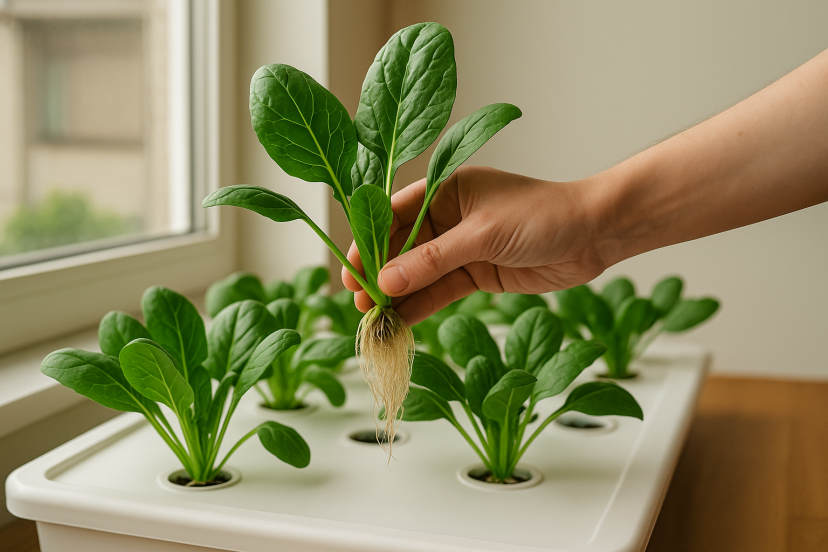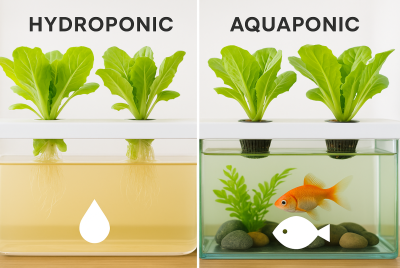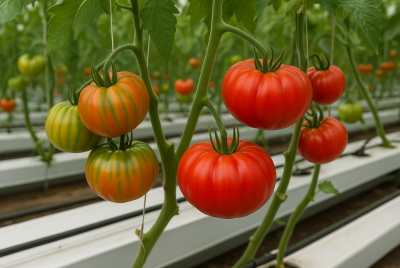12 Fall Garden Vegetables You Can Grow Hydroponically
We may earn a commission for purchases made using our links. Please see our disclosure for more details.
When the air turns crisp and the trees trade their green for gold, most gardeners tuck away their tools and call it a season. But if you’ve ever stood over your fading garden beds and thought, “There has to be a better way,” you’re absolutely right. Fall weather brings moody temperatures, short daylight hours, and soil that just won’t cooperate, making it tough to keep your plants thriving. The good news is, you don’t have to surrender your harvest to the cold—hydroponic gardening lets you grow fresh, flavorful fall garden vegetables year-round without worrying about frost, pests, or muddy soil. With total control over nutrients, light, and water, you can keep your greens crisp, your roots crunchy, and your garden thriving long after the first frost settles in.
Why Grow Fall Vegetables Hydroponically?
Hydroponics enhances traditional gardening practices. Instead of relying on soil, fall garden vegetables grow directly in nutrient-rich water, which provides them with just what they require at the right time. This implies faster growth, higher yields, and less pest and weed problems.
According to a study published in Frontiers in Plant Science (2023), hydroponic systems can increase yield and nutrient absorption while consuming up to 90% less water than soil-based approaches. For anyone tired of dealing with uncertain fall weather, hydroponics provides regularity and control—two things that every gardener secretly desires.
If you’re new to this setup, start with something simple like basil. This easy herb helps you learn how nutrient solutions and pH levels work together. Check out this guide on how to grow hydroponic basil to get started.
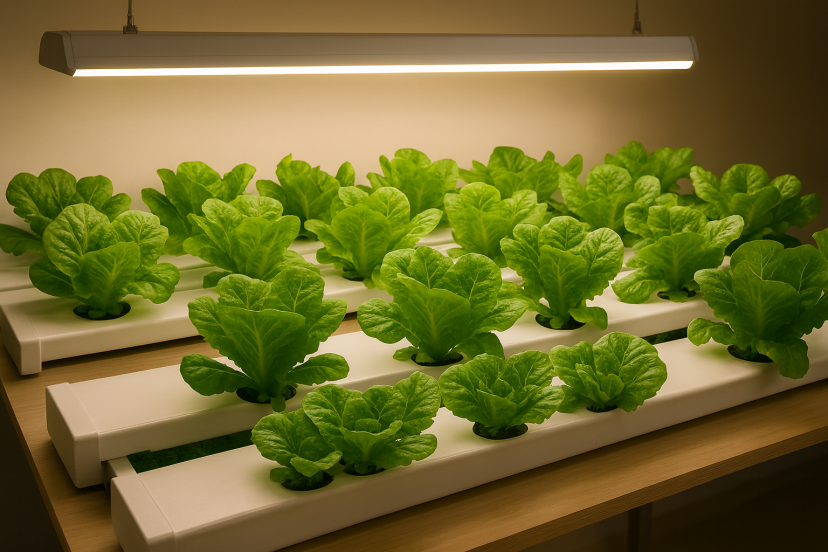
1. Lettuce – The Cool-Weather Favorite
Lettuce thrives in the cooler months, making it one of the best fall garden vegetables for hydroponics. Romaine, Butterhead, and Bibb thrive in systems like Deep Water Culture (DWC) and Nutrient Film Technique (NFT). Sprouting typically occurs within a few days, and crisp, delicious leaves can be harvested in as little as three weeks.
Tip: Keep the nutrient solution between 6.0 and 6.5 pH for lush growth.
2. Spinach – Packed with Iron and Flavor
Spinach grows quickly and stays vibrant in cool, controlled environments. This leafy green prefers strong LED lighting and steady airflow. Studies published in the Journal of Agricultural and Food Chemistry show that hydroponically grown spinach maintains high vitamin C and antioxidant levels when grown under full-spectrum light—meaning it’s both fresh and nutrient-dense.
3. Kale – The Nutrient Powerhouse
Known for its resilience, kale thrives in hydroponic systems even when temperatures dip into the low 60s°F. It’s loaded with vitamins A, C, and K, and offers a steady harvest that keeps coming back. Whether you prefer it in smoothies or roasted as crispy chips, kale is one of those crops that just keeps giving.
4. Swiss Chard – Colorful and Resilient
Swiss chard adds a beautiful burst of color to your indoor garden. Its rainbow stems and glossy leaves grow fast in hydro setups like the Kratky method. It loves cooler temperatures (around 65°F) and low humidity. Harvest the outer leaves regularly to encourage new growth—it’s almost effortless once it’s established.
5. Arugula – Fast-Growing and Peppery
Arugula’s sharp, peppery flavor brings excitement to fall salads. It’s one of the quickest hydroponic crops, sprouting in days and ready for harvest in about three weeks. It prefers moderate light and cool air. Plus, because it grows so fast, it’s a great confidence booster for new hydroponic gardeners.
6. Carrots – Small But Mighty
While root crops can be tricky, carrots actually perform well hydroponically if you choose smaller varieties like Thumbelina or Parisian. Use a deep container with a mix of coco coir and perlite for good root expansion. Keep your water well-oxygenated and your patience steady—these little guys take about 70 days but are totally worth it.
7. Beets – Sweet Roots, Edible Greens
Beets do great in deep-water hydroponic setups. The roots grow round and sweet, while the tops make excellent sautéed greens. Maintain a slightly acidic pH (around 6.2) for best results. You’ll get not just one but two edible parts from the same plant—a fall win for any gardener.
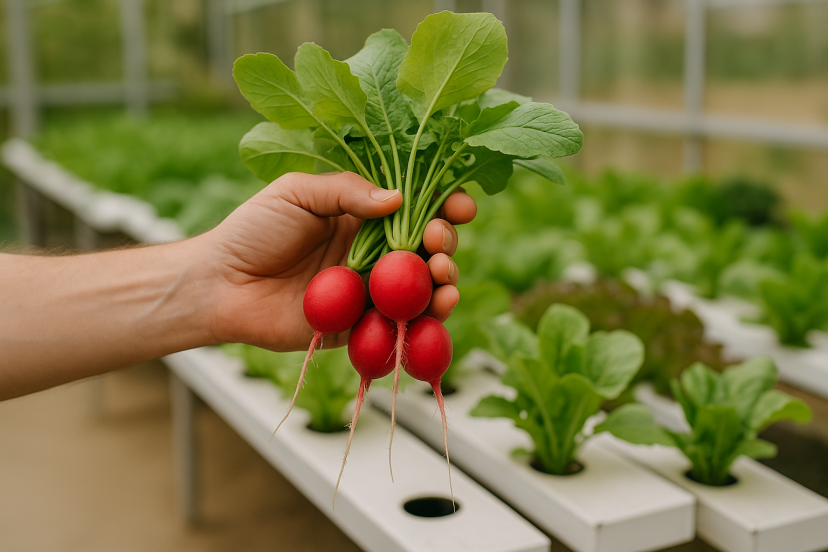
8. Radishes – The Quickest Crop
If you want instant gratification, radishes are your go-to. They grow fast, thrive in cooler temps, and don’t need much space. Within 20–25 days, you’ll have crunchy, spicy bulbs ready for your kitchen. Bonus: they make a great teaching crop for kids learning about hydroponics.
9. Broccoli – The Cold-Loving Classic
Broccoli is perfect for fall hydroponic systems because it enjoys cool weather. Keep nitrogen levels high early in its growth, then lower them as the florets start forming. A study in Horticultural Science and Technology showed that hydroponically grown broccoli had higher glucosinolate levels—compounds linked to cancer prevention—than soil-grown varieties.
10. Cauliflower – Gentle but Rewarding
Cauliflower can be a little sensitive, but once you find the right balance of nutrients and humidity, it rewards you with large, tight heads. Keep the temperature steady at 60°F and ensure strong airflow to prevent mildew. It’s a challenge, but one that feels extra satisfying when you pull off a perfect harvest.
11. Green Onions – Effortless and Endless
Growing green onions—better known as scallions—is about as easy as gardening gets. You can bring them back to life by simply replanting the roots from your kitchen leftovers. Place the roots in your hydroponic reservoir, and within days, you’ll see new green shoots. They keep producing over and over again, making them a low-maintenance addition to your fall garden lineup.
12. Peas – Sweet Pods for Cool Weather
Peas love mild conditions, so fall hydroponic systems are practically made for them. Trellis them upward to save space and let them bask in gentle light. Varieties like Sugar Snap or Snow Peas offer crisp, sweet pods that taste like spring, even when the weather says otherwise.
Top 5 Recommended Products
- AeroGarden Harvest Indoor Garden – Ideal for small spaces and beginner hydro gardeners.
- General Hydroponics Flora Series Nutrient Kit – Balanced nutrients for all plant stages.
- VIVOSUN Full-Spectrum Grow Light – Reliable lighting that mimics natural sunlight.
- EcoPlus Air Pump – Keeps water oxygenated to promote strong root systems.
- Hydrofarm 10-Gallon Reservoir Kit – Durable and perfect for larger fall crops.
Why Experts Say Hydroponics Is the Smart Way to Grow
If you love a good reason to geek out about gardening science, this part’s for you. Researchers have been comparing hydroponics with traditional soil gardening for years—and the findings make it clear why so many experts call hydroponics the “smart” way to grow.
Lettuce That Grows Like It’s on Fast-Forward
A 2024 study titled Comparative Analysis of Hydroponically and Soil-Grown Lettuce found that lettuce grown in an NFT system grew taller, developed more leaves and achieved greater biomass than soil-grown plants. On the flip side, the soil-grown lettuce delivered higher levels of phenolics, flavonoids and antioxidant activity.
💡 Takeaway: Hydroponics wins on size and speed—especially useful for short fall days—but if you’re after maximum antioxidant value, a little extra attention on lighting and nutrient optimization will help you close the gap.
Hydroponics: Efficiency Meets Sustainability
A study titled Hydroponic vs. Soil Cultivation of Lettuce and Spinach tested both growing methods in a high-altitude greenhouse in the Trans-Himalayan region. The results were impressive: plants grown hydroponically showed significantly higher yields and better overall quality compared to those grown in soil.
Researchers noted that hydroponic systems helped maintain steady growth even in harsh, cold climates where soil farming struggles. The method also used far less water and produced cleaner, healthier crops.
💡 Takeaway: Hydroponics proves its worth not just for convenience but for resilience—it’s an efficient, science-backed way to grow strong, nutrient-rich fall garden vegetables no matter the season or setting.
Tips for Success in Fall Hydroponics
- Adjust lighting: Use full-spectrum LEDs to mimic sunlight during shorter days.
- Monitor pH and EC: Keep an eye on your nutrient balance for steady growth.
- Control temperature: Maintain around 65–70°F for most vegetables.
- Harvest often: Regular trimming encourages continuous regrowth.
Conclusion
Growing fall garden vegetables hydroponically is like giving your plants a cozy indoor upgrade. No frost, no mud, no guesswork—just thriving greens and colorful harvests when most gardens are shutting down. Whether you’re after quick wins like lettuce and arugula or hearty crops like broccoli and beets, hydroponics gives you the tools to grow smarter, not harder. So grab your grow light, mix your nutrients, and get growing—your fall harvest is just beginning.
FAQs
1. Can you grow all vegetables hydroponically in fall?
Not all, but most cool-weather vegetables like lettuce, spinach, kale, and arugula thrive in hydro systems.
2. What lighting is best for indoor fall gardening?
Full-spectrum LED grow lights provide the right balance of red and blue wavelengths for strong plant growth.
3. When should you replace the hydroponic nutrient water?
Every two to three weeks, depending on plant size and system type.
4. Does hydroponic gardening really save water?
Yes! Studies show it can reduce water use by as much as 90% while maintaining strong yields.
5. What’s the easiest fall vegetable for beginners?
Lettuce—it grows fast, requires little maintenance, and rewards you quickly.

